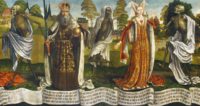On October 30th, 1938, a radio broadcast on the CBS Radio station "The War of…

Historic Epidemics: The "New Normal" after the Black Death
How could any good come from a pandemic that devastated the known world?
Hard to believe, but in the aftermath of the Great Pestilence of the fourteenth century, people were–in general– better off than they were before, at least economically
Before the onset of the Bubonic plague in 1350, Europe was a predominantly agrarian society, with a social structure that consisted of three orders:
- Nobility (5%): those who owned the land and had means to protect it with soldiers, weapons, and horses.
- Clergy (5%): The priests, monks, and nuns whose duty it was to pray for humanity and save all from sin. These usually came from the ranks of the nobility as second sons or daughters.
- Peasants (90%): Those who worked the land and provided food as a tribute to their landowners and a tithe to their clergy.
In addition, most of Europe during this time was faced with a land shortage. That meant that there was not enough land to feed everyone, and a lot of peasants to work it. This led to most of the population eeking out a barely subsistence living on the land where they were born, with no possibility of upward mobility or hope of improvement to their lot in life.

Fifty years later, after the Black Death took a toll of between thirty and fifty percent of the population, the situation of those lucky enough to survive changed–in the most part, for the better.
Mobility: The noble landowners suddenly found themselves with a greatly reduced labor force or, in cases where entire villages died or picked up and left, with no labor force at all. Those peasants who remained could demand cash wages–and high ones– for everything from field work to shoeing horses to burying the dead. If the nobles weren’t willing to pay, the surviving peasants could walk down the road to the next noble household, who surely would. Or country folk could pick up and move to a city that was badly in need of both skilled and unskilled laborers, and they often did.
Wealth: In many villages, so many died that only one person would remain to inherit the land, animals, and housing of their extended family. This led to a concentration of wealth among survivors. A man who had previously had little wealth but was lucky enough not to die could come out of the plague with several houses, tracts of land, and herds of livestock.
Rise of the Merchant Class: The merchants had been a small outlier in the three-estate system of feudal Europe, now–with laborers having cash to spend from their higher wages–merchants started to acquire wealth on par with the richest nobles. The noble class had lost a great deal of their wealth and lands due to the labor shortage, and so began marrying their daughters to the wealthy merchants as a way to stabilize their family incomes. This raised the social standing of the merchants to almost-nobility.
Women: While before the onset of the plague, most trades had been the domain of men, after the plague that wasn’t the case. Women who had helped their husbands as bakers, apocatheries, and even blacksmiths found that–with their husbands dead–they were the only ones in the village to step up and bake the bread, provide the medicine, and shoe the horses. And so they did, commanding the wages–if not the respect–that had once been their husband’s.
Clergy: The church, too, inherited from the deaths of nobles and benefactors. In fact, they had so much land and estates that they no longer needed large dowries from the families of their priests and religious. Therefore, the lower classes of merchants and peasants were accepted into the ranks of the clergy for the first time in hundreds of years, changing the nature of the Medieval church in a substantial way.
You could say that after all the death and terror of the Great Pestilence, the “new normal” was better than what had come before. In fact, historians suggest that the plague was a major factor in moving European society from the Dark Ages into the Renaissance and without it, Europe would have languished under the feudal system for another thousand years.
Unfortunately, the people of the world hadn’t seen the last of the Black Death. It was to recur with regularity–but not equal devastation– about every ten years until the last major outbreak in the 1660s.
What will our “new normal” look like after the Covid-19 has passed? Do you think we can look for anything positive to come from this worldwide pandemic?
Read my the other posts on Historic Epidemics:
Parrot Fancier’s Fever: Part 1 — how my daughter and her quail keeping led to learning of a 1930s epidemic
Parrot Fancier’s Fever: Part 2 — how a 1930s epidemic led to the creation of the National Institute of Health
Historic Epidemics: Malaria in the Vatican 1623 — How the indigenous people of South American saved millions of lives
Historic Epidemics: The Spanish Flu didn’t come from Spain — how politics and the media put the spin on Influenza
Historic Epidemics: The Plague Doctor — how the strange costume of the plague doctors may have actually protected them from the disease
Historic Epidemics: Sweden and the Black Death
This Post Has One Comment
Comments are closed.


Our church has more views of our Sunday morning service than we used to have people in attendance. I have heard the same from other churches. That says to me that there are a lot of spiritually hungry people out there at this time. May their faith grow, and when we return to meeting together, may we find many new brothers and sisters among us.